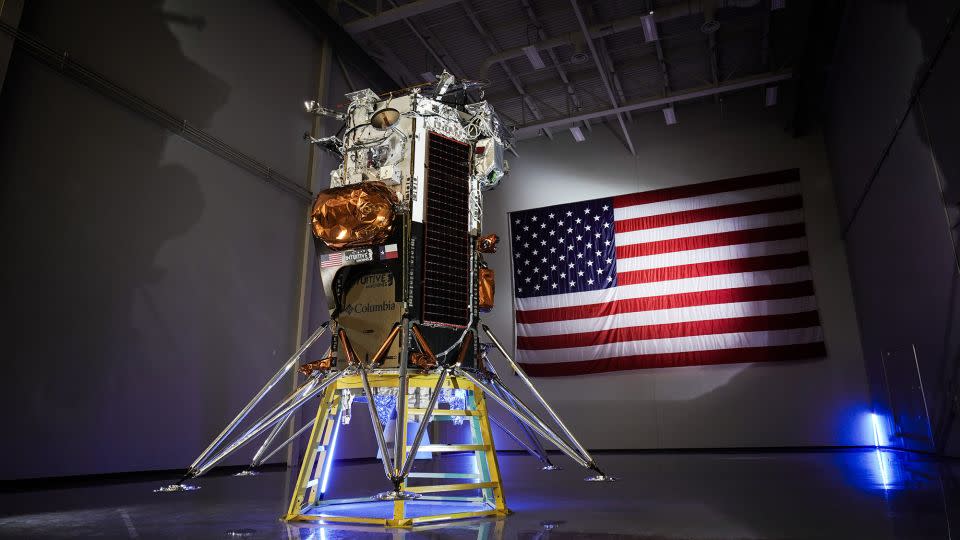Sign up for CNN’s Wonder Theory science newsletter. Explore the universe with news on exciting discoveries, scientific advances and more.
The lunar lander Odysseus, nicknamed “Odie,” is set to embark on a historic journey to the lunar surface – aiming to make the first trip by a US spacecraft to the moon in five decades.
The upcoming launch attempt closely follows a separate US lunar landing mission that failed in January. NASA has boosted the development of robotic spacecraft through private partners to assess the lunar environment and identify key resources – such as the presence of water – before it tries to return astronauts to the moon later in the decade.
Odie is scheduled to launch atop a SpaceX Falcon 9 rocket at 1:05 a.m. ET Thursday from NASA’s Kennedy Space Center in Florida. A webcast of the launch will begin about 45 minutes before the expected takeoff, according to SpaceX.
The mission was scheduled to launch on Wednesday, but the attempt was delayed by 24 hours due to the temperature of the propellant needed to power the spacecraft.
A trip to the moon
The rocket is expected to launch Odie into Earth orbit, hurtling to speeds exceeding 24,600 miles per hour (11 kilometers per second), according to Intuitive Machines, the Houston-based company that developed the spacecraft under contract with NASA through its Commercial Lunar Payload Services. program.
Odie’s path will be “a high-energy fastball pitch toward the moon,” as Stephen Altemus, CEO of Intuitive Machines, put it.
After burning its fuel, the rocket will separate from Odie, leaving the lunar lander to fly solo through space. Designed with autonomous features, the robotic explorer will instantly consult an onboard map of the stars so it can orient itself in space. The spacecraft will point its solar panels towards the sun’s rays to charge its batteries.

Odie will be on an oval path around Earth, stretching as far as 380,000 kilometers (236,100 miles) from home. At about 18 hours into the spaceflight, the vehicle will ignite its engine for the first time, continuing its high-speed journey toward the lunar surface.
The moon, which orbits about 250,000 miles (400,000 kilometers) from Earth, is expected to give Odie a gentle gravitational tug as the spacecraft approaches, pulling the vehicle toward its ragged surface.
Odie is scheduled to make his nail-biting attempt on February 22, aiming for a crater near the moon’s south pole.
It will be a dangerous trek. If Odie fails, it will join a growing list of failed missions to the moon: A critical fuel leak stalled the first US-built lunar lander in five decades, Falcon Astrobotic Technology, last month. That came after two failed missions from other countries in 2023: one from Russia and another from a company based in Japan.
So far China, India and Japan are the only nations that have landed soft vehicles on the moon in the 21st century.
What will Odie do on the moon
Odie’s trip to the moon can be considered a scouting mission of sorts, designed to assess the lunar environment before NASA’s current plan to return a crewed mission to the moon through the Artemis program in late 2026.
The south pole of the Moon is an area of widespread interest among new international space races, as the region is thought to contain stores of water ice. The precious resource could be converted into drinking water for astronauts or even rocket fuel for missions that explore deeper into space.
Six payloads of NASA science and technology are packed aboard the lunar lander. They include a radio receiver that will study lunar plasma, which is created by solar winds and other charged particles raining down on the moon’s surface.
Other payloads will test technology that could be used on future lunar landing missions, such as a new sensor that could help guide precision landings.
The Navigation Doppler Lidar, as the sensor is called, “shoots laser beams to the ground and measures spacecraft velocity – that’s speed – and direction of flight,” said Farzin Amzajerdian, principal investigator of the lidar payload at NASA’s Langley Research. Center in Hampton, Virginia.
Also on board will be technology and commemorative payloads from the private sector. Columbia Sportswear, for example, developed a special insulating material that could help protect Odie from the extreme temperatures of the moon. A small sculpture representing the phases of the moon — designed in consultation with artist Jeff Koons — will also be placed on board.
Odie also has a camera system called EagleCam that was developed by students at Embry-Riddle Aeronautical University in Daytona Beach, Florida. The device is set to be lowered from the lunar lander as it approaches the surface and captures images of the vehicle’s descent.
“Hopefully we’ll get a visual of that landing to share with the public,” Altemus said.
Odie is expected to operate on the lunar surface for seven days before darkness falls on the landing site, blocking the spacecraft’s solar panels from the sun and plunging into freezing temperatures.
For more CNN news and newsletters create an account at CNN.com